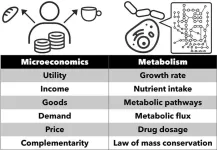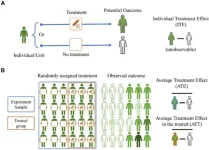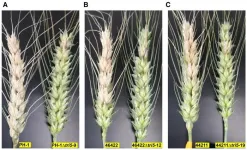Red pill or blue pill? The critical decision to control the superbugs
2023-07-13
(Press-News.org)
Researchers from Tokyo Medical and Dental University (TMDU) investigate a pharmacist-led intervention to optimize the oral antimicrobial prescriptions in dental setting
Tokyo, Japan - The battle to stop the increase of superbugs in hospitals has been an ongoing struggle for healthcare professionals. Dentists are currently facing a medical challenge that determines the faith of antimicrobial resistance in healthcare settings. To choose the “red pill” means to embrace the painful truth that bacteria are acquiring resistance to many antimicrobials. Meanwhile, the “blue pill” creates blissful ignorance prompting unwarranted habits that increase the incidence of serious infectious diseases.
In a study published recently in the Journal of Hospital Infection, researchers from Tokyo Medical and Dental University (TMDU) revealed that Antimicrobial Stewardship Programs (ASP) can promote the appropriate use of antimicrobials in dentistry and hence prevent antimicrobial resistance.
The public health emergency that overwhelmingly haunts the minds of healthcare providers is the rise of superbugs in healthcare settings. Although most multi-drug resistant organisms are found most often in intensive care units and in hospital settings, dental clinics are not immune to this infectious plague, especially amidst a trend increasing of antimicrobial consumption. In April 2016, a national action plan for antimicrobial resistance from the Ministry of Health, Labour and Welfare was introduced in Japan. ASP teams and ASP pharmacists are a response to the challenge of antimicrobial resistance, to optimize antimicrobial prescription, control transmission of infections, and educate healthcare professionals on the appropriate use of antimicrobials.
“Pharmacist-led ASPs are effective interventions in healthcare; therefore, introducing this practice in an unexplored environment is critical to managing the superbugs,” explains the first author of the study Rie Okihata. “In this research, we aimed to evaluate the efficacy of pharmacist-led multi-faceted intervention in an outpatient dental clinic.”
The 7-year trial was conducted at dental clinics in Tokyo Medical and Dental University Hospital. The data from electronic medical records were reviewed before and after the pharmacist-led intervention to analyze the monthly proportion of oral antimicrobial prescriptions in eight antimicrobial drug classes: penicillins, first- and second-generation cephalosporins, third-generation cephalosporins (3-GCs), fluoroquinolones (FQs), macrolides, carbapenems, and clindamycin. The multi-faceted intervention consisted of several main techniques: post-prescription feedback, a recommendation to administer penicillin, discontinuation of 3-GCs – an antimicrobial with negative effects – and an educational program for dental students.
The study intervention increased the proportion of penicillins in oral antimicrobial prescriptions. In contrast, the proportion of 3-GC prescriptions decreased significantly and that of broad-spectrum antimicrobials such as FQs, macrolides, and carbapenems decreased gradually. The results from the ASP pharmacist-led multifaceted intervention in an outpatient dental clinic were promising. “In the eyes of a dentist, an ASP pharmacist-led intervention is a powerful force that suppresses multi-drug resistant pathogens,” says Yasuaki Tagashira, corresponding author.
Optimization of antimicrobial prescription prevents pharmacists from turning a blind eye to the “one size fits all” ideology and allows them to embrace the truth that a patient-centered approach is a key contributor to controlling the emergence of superbugs in any medical care environment.
###
The article, “Pharmacist-led multi-faceted intervention in an antimicrobial stewardship programme at a dental university hospital in Japan,” was published in The Journal of Hospital Infection at DOI: https://doi.org/10.1016/j.jhin.2023.04.006
END
ELSE PRESS RELEASES FROM THIS DATE:
2023-07-13
A team from the University of Tokyo has combined economic theory with biology to understand how natural systems respond to change. The researchers noticed a similarity between consumers’ shopping behavior and the behavior of metabolic systems, which convert food into energy in our bodies. The team focused on predicting how different metabolic systems might respond to environmental change by using an economic tool called the Slutsky equation. Their calculations indicated that very different metabolic ...
2023-07-13
Manganese-rich NASICON-type materials have attracted widespread attention for developing advanced polyanionic cathodes, primarily driven by their abundant reserves, promising cycling performance, and potentially high operating voltage.
Unfortunately, their charge/discharge profiles exhibit significant voltage hysteresis, which leads to a limited reversible capacity, thereby preventing their application.
Now, however, the situation may be changing due to research by scientists at the Institute of Process Engineering (IPE) and the Institute of Physics of the Chinese Academy of Sciences. They recently identified ...
2023-07-13
Clean energy plans, including the U.S. Infrastructure Investment Act’s “Clean Hydrogen Road Map,” are counting on hydrogen as a fuel of the future. But current hydrogen separation technology is still falling short of efficiency and sustainability goals. As part of ongoing efforts to develop materials that could enable alternative energy sources, researchers in Drexel University’s College of Engineering have produced a titanium oxide nanofilament material that can harness sunlight to unlock the ubiquitous molecule’s potential as a fuel source.
The discovery offers an alternative ...
2023-07-13
A Perspective published in Volume 3 of the journal Psychoradiology, researchers from Shanghai Jiao Tong University confronted these challenges and advocates for more clarity and transparency in causal analyses. The review distinguishes between traditional statistical analysis and causal inference, highlighting the need for specific causal assumptions, like the Stable Unit Treatment Value Assumption (SUTVA).
Randomized controlled trials (RCTs) are considered the gold standard for estimating causal effects. The authors stress the importance of imitating RCTs in observational studies through quasi-experimental techniques, ...
2023-07-13
Gero, an AI-driven biotech focused on aging and longevity, has demonstrated the feasibility of applying quantum computing for drug design and generative chemistry, which now offers significant promise for the future of healthcare. The research, published in Scientific Reports, outlines how a hybrid quantum-classical machine-learning model was used to interface between classical and quantum computational devices with the goal of generating novel chemical structures for potential drugs — an industry first.
The research paper follows ...
2023-07-13
A new study suggests eastern wild turkeys in five southern U.S. states are unlikely to make meaningful changes in the timing of when they begin nesting, even under significant future climate change.
The findings suggest eastern wild turkeys (Meleagris gallopavo silvestris) could be vulnerable to shifts in climate, which could threaten the availability of their food sources, the amount of vegetation cover available to protect them from predators, and other factors.
“There are implications here for turkey populations ...
2023-07-13
Although wheat was among the first domesticated food crops, it remains a global dietary staple several millennia later. Grown on every continent except Antarctica, wheat is the second highest produced grain worldwide, with nearly 800,000 metric tons grown each year (Food and Agriculture Organization). However, a fungal pathogen named Fusarium graminearum causes the devastating disease Fusarium head blight (FHB) on wheat and contaminates grains with harmful toxins called trichothecenes. One such trichothecene, called deoxynivalenol (DON), is produced by most F. graminearum strains in the United States, and it is an essential virulence factor that increases the pathogen’s spread ...
2023-07-13
Currently, there is no cure for amyloidosis, a life-threatening disease that can be present throughout the body, including the heart, kidneys, liver and brain. The most common localized form of amyloidosis, which is seen significantly more often, is in the brain. Cerebral amyloidosis, when symptomatic, usually manifests in one of two ways: in Alzheimer’s disease and related dementias and in brain bleeds, which have consequences such as a stroke.
Because amyloidosis does not affect a specific organ, unraveling the underlying cause of amyloid fibril creation – a hallmark ...
2023-07-13
SAN FRANCISCO—Schmidt Marine Technology Partners, a program of the Schmidt Family Foundation, has awarded $3.5 million in grants to ten organizations and universities in seven countries for the development of new tools and innovations that will improve the sustainability of global fisheries, the program announced today.
“Tens of millions of jobs around the world depend on fisheries, and seafood is the primary protein source for 3 billion people,” said Wendy Schmidt, president and co-founder of the Schmidt Family Foundation. “The innovators chosen to receive these grants are ensuring that fishers and ...
2023-07-13
A University of Minnesota Twin Cities team has, for the first time, synthesized a thin film of a unique topological semimetal material that has the potential to generate more computing power and memory storage while using significantly less energy. The researchers were also able to closely study the material, leading to some important findings about the physics behind its unique properties.
The study is published in Nature Communications, a peer-reviewed scientific journal that covers the natural sciences and engineering.
As evidenced by the United States’ recent CHIPS and Science Act, there is a growing need to increase semiconductor manufacturing ...
LAST 30 PRESS RELEASES:
[Press-News.org] Red pill or blue pill? The critical decision to control the superbugs






